Endoscopic management of post-liver transplant biliary complications
- PMID: 25992185
- PMCID: PMC4436914
- DOI: 10.4253/wjge.v7.i5.446
Endoscopic management of post-liver transplant biliary complications
Abstract
Biliary complications are being increasingly encountered in post liver transplant patients because of increased volume of transplants and longer survival of these recipients. Overall management of these complications may be challenging, but with advances in endoscopic techniques, majority of such patients are being dealt with by endoscopists rather than the surgeons. Our review article discusses the recent advances in endoscopic tools and techniques that have proved endoscopic retrograde cholangiography with various interventions, like sphincterotomy, bile duct dilatation, and stent placement, to be the mainstay for management of most of these complications. We also discuss the management dilemmas in patients with surgically altered anatomy, where accessing the bile duct is challenging, and the recent strides towards making this prospect a reality.
Keywords: Bile leak; Biliary; Biloma; Cast; Complications; Endoscopic retrograde cholangiography; Endoscopy; Liver transplant; Management; Stone; Strictures.
Figures






Similar articles
-
[External biliary fistulas selectively managed by endoscopic retrograde cholangiography with sphincterotomy and/or stent placement].Chirurgia (Bucur). 2006 May-Jun;101(3):281-8. Chirurgia (Bucur). 2006. PMID: 16927917 Romanian.
-
Biliary disease after liver transplantation: the experience of the King Faisal Specialist Hospital and Research Center, Riyadh.J Gastroenterol Hepatol. 2005 Feb;20(2):217-28. doi: 10.1111/j.1440-1746.2004.03490.x. J Gastroenterol Hepatol. 2005. PMID: 15683424
-
Endoscopic management of bile duct injury after hepatobiliary tract surgery: a comprehensive review.Minerva Chir. 2016 Dec;71(6):398-406. Epub 2016 Sep 2. Minerva Chir. 2016. PMID: 27589348 Review.
-
An endoscopic approach to biliary complications following orthotopic liver transplantation.Liver Int. 2003 Jun;23(3):156-62. doi: 10.1034/j.1600-0676.2003.00823.x. Liver Int. 2003. PMID: 12955878
-
Current diagnosis and treatment of benign biliary strictures after living donor liver transplantation.World J Gastroenterol. 2016 Jan 28;22(4):1593-606. doi: 10.3748/wjg.v22.i4.1593. World J Gastroenterol. 2016. PMID: 26819525 Free PMC article. Review.
Cited by
-
Comparison of time-to-event machine learning models in predicting biliary complication and mortality rate in liver transplant patients.Sci Rep. 2025 Feb 8;15(1):4768. doi: 10.1038/s41598-025-89570-4. Sci Rep. 2025. PMID: 39922959 Free PMC article.
-
Percutaneous cholangioscopy-assisted rendezvous endoscopic retrograde cholangiography technique for a difficult postliver transplant anastomotic stricture.VideoGIE. 2025 Mar 21;10(8):402-405. doi: 10.1016/j.vgie.2025.03.025. eCollection 2025 Aug. VideoGIE. 2025. PMID: 40704122 Free PMC article.
-
A Review on the Management of Biliary Complications after Orthotopic Liver Transplantation.J Clin Transl Hepatol. 2019 Mar 28;7(1):61-71. doi: 10.14218/JCTH.2018.00028. Epub 2018 Dec 3. J Clin Transl Hepatol. 2019. PMID: 30944822 Free PMC article. Review.
-
Biliary and Vascular Complications after Liver Transplantation-From Diagnosis to Treatment.Medicina (Kaunas). 2023 Apr 28;59(5):850. doi: 10.3390/medicina59050850. Medicina (Kaunas). 2023. PMID: 37241082 Free PMC article. Review.
-
Bleeding after Percutaneous Transhepatic Biliary Drainage: Incidence, Causes and Treatments.J Clin Med. 2018 May 1;7(5):94. doi: 10.3390/jcm7050094. J Clin Med. 2018. PMID: 29723964 Free PMC article. Review.
References
-
- Ayoub WS, Esquivel CO, Martin P. Biliary complications following liver transplantation. Dig Dis Sci. 2010;55:1540–1546. - PubMed
-
- Seehofer D, Eurich D, Veltzke-Schlieker W, Neuhaus P. Biliary complications after liver transplantation: old problems and new challenges. Am J Transplant. 2013;13:253–265. - PubMed
-
- Wojcicki M, Milkiewicz P, Silva M. Biliary tract complications after liver transplantation: a review. Dig Surg. 2008;25:245–257. - PubMed
-
- Jagannath S, Kalloo AN. Biliary Complications After Liver Transplantation. Curr Treat Options Gastroenterol. 2002;5:101–112. - PubMed
Publication types
LinkOut - more resources
Full Text Sources
Other Literature Sources
Miscellaneous

